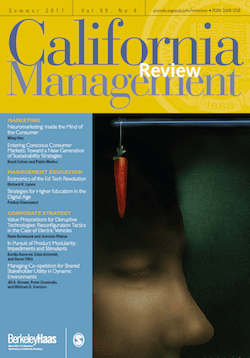Like DNA tests gathered by investigators to solve a crime, human brain scans can provide key evidence for marketers trying to better understand consumer behavior.
At the same time, just like DNA tests, there are clear limits to what a peek into the brain can tell marketers, says Ming Hsu, an associate professor in the Berkeley-Haas Marketing Group and the Helen Wills Neuroscience Institute at UC Berkeley.
In “Neuromarketing: Inside the mind of the consumer,” an article published in the new California Management Review, Hsu aims to set realistic goals and expectations about what the application of neuroscience to marketing can and can’t do. Hsu’s case is among seven new articles included in the current issue, including an article by Berkeley-Haas Dean Rich Lyons on “Strategies for Higher Education in the Digital Age.”

In his article, Lyons explores how new technology, including artificial intelligence, machine learning, and mobile, are changing how education is delivered and structured. The article outlines eight examples of ways in which technology will be used to rethink everything from how students learn to how to train faculty to use their classroom time more efficiently.
“Ed tech is already changing the education product,” Lyons writes. “Therein lies its disruptive potential.”
One example is MATLAB, a coding course at UC Berkeley that used to be taught solely in a traditional classroom, but is now also taught online. The online format gives students access to a quick feedback loop that relies on a grading engine: students submit code and get instant feedback and help with problem areas. Students so loved the iterative part of the course that the engine is now used to teach the traditional campus versions of the same course. “This is a different product, not the same product distributed through a new channel,” Lyons writes.
Meantime, Hsu’s case discusses how neuroscience promises products that directly measure customers’ underlying thoughts, feelings, and intentions by testing a multitude of responses coming from the brain. The key differentiator of brain-based techniques is that they separate what people say they think from what they actually think, Hsu says.
Common tools used include EEG, or electroencephalogram, a test that detects electrical activity using small, flat electrodes attached to the scalp; PET, or positron emission tomography imaging; and functional MRI (magnetic resonance imaging), which measures brain activity by detecting changes associated with blood flow. Indeed, these techniques are more expensive than traditional methods such as focus groups, and that expense tends to inflate expectations.
“Managers sometimes have a vision that brain recordings are effortlessly translated into customer insights and delivered with a bow,” Hsu said. “But that’s like asking DNA evidence to completely replace tools likes suspects’ interview, crime scene observation, or general critical thinking. The inability to reconstruct the suspects’ profiles from DNA evidence alone has not made the impact of genetic testing on forensics any less profound.”
Hsu suggests using tools to complement traditional approaches, not replace them; taking insights from focus groups or surveys and testing them using brain-based methods. This is particularly important when it comes to decisions in marketing and brand strategy, which often address questions regarding how customers think, feel, and respond to a company’s offerings.
Getting the wrong answers can mean costly mistakes that take years, even decades, to become apparent, let alone correct, Hsu said. “A growing problem today is the inundation of data from customer focus groups, surveys, and social media, some of which can be mutually inconsistent and contradictory,” he said. “Brain based methods allow marketers to validate, prioritize, and select among putative insights generated from this mountain of data.”
About California Management Review: Published quarterly, California Management Review is a top-ranked management journal that serves as bridge of communication between those who study management and those who practice it.
To subscribe, visit cmr.berkeley.edu.